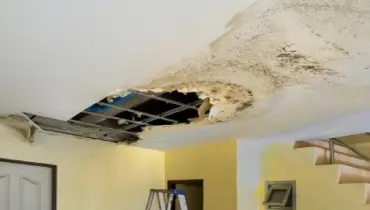
When landlords are asked what type of property damage they worry about the most, water damage is at the top of the list. Not only is it expensive to fix, water damage can cause long-term damage to your property if it’s not handled correctly. That’s why it’s so important, as a landlord, for you to have a proactive plan that covers the possibility of water damage on your properties—especially if your property is located in a flood-prone area. Reviewing the common causes of water damage, working with your tenants, and knowing your responsibilities as a landlord will help you have a plan of action in case the worst happens or if you experience tenant negligence water damage. By planning ahead and taking a proactive approach you’ll know how to deal with water damage before it happens.
Learn the Common Causes of Water Damage
If your property sits in a flood-prone area, you already know that it’s at risk for water damage. But flooding can come from many other sources, including:
-
Burst pipes—most common with old or frozen pipes.
-
Overflowing toilets or bathtubs.
-
Leaky roofs—may only show up during periods of heavy rain.
-
Leaking or broken water heater—can go unnoticed if located in an attic, closet, or garage.
-
Leaking appliances—washers and dishwashers are the biggest culprits.
-
Tenant belongings—like waterbeds or fish tanks.
Deal with Flooding Quickly
Water can cause damage rapidly—especially if you’re not there or can’t get there when it happens. To keep the water damage to a minimum, make sure your tenants know what to do in case of flooding.
-
Show tenants how to shut off the water.
If an appliance or fixture like the dishwasher, washing machine, toilet or sink is leaking, make sure the tenant knows where the individual shutoff valves are so they can stop the localized water flow. If the source of the leak is a burst pipe or a slow leak you can’t see, leave instructions describing how to shut off the water main and how to contact a plumber with 24/7 emergency service.
-
Remove excess water quickly.
If spilled water is the culprit (overflowing bathtub, fish tank spill, etc.) let the tenant know that their first priorities are to make sure no more water is released. Instruct them to use some old towel towels to soak up any standing water. Only after they’ve completed these actions should they call you. Since the true extent of water damage isn’t always apparent. Once you see that there is water intrusion, contact a professional for proper extraction and inspection of water damage and remediation to minimize further damage.
-
Protect the furnishings.
If flooding is caused by a storm, make sure your tenants know that their safety is more important than the property. However, if it will not put them in danger, encourage them to remove their books, papers, fabrics, or any other items that might be ruined by the water. If possible, ask them to put aluminum foil or wax paper under the legs or feet of their furniture and lift curtains, drapes, and upholstered furniture skirts away from the wet carpet. These simple actions can make the flood recovery go much faster. Remember that water damage that occurs from rising rivers, streams or hurricanes contains biologic contaminants that need to be cleaned and treated by a certified disaster professional.
If the water is the result of roof damage, when it’s safe to do so, locate and cover the area (source of the leak) temporarily to prevent further damage. Once the storm has passed permanent repairs to the roof can be done. However, before any ceiling repair water damage and/or drywall repair water damage is started the areas should be inspected by a restoration professional. They will make sure the affected areas are thoroughly dry before any repairs begin. This will reduce the risk of mold on ceiling and walls, which can create a bigger, more expensive problem.
Related Topic: After the Flood—Watch Out for These 7 Hazardous Situations
Call a Water Damage Professional
As the landlord, it’s your job to make sure your rental property is habitable and safe for tenants again in a same and prompt manner. Because mold can form so quickly, waiting to deal with water damage can cause your property to become uninhabitable. So, even though it may be tempting to try to clean up water damage yourself, it’s better to call a professional to make sure the wet area is dried out correctly and safe for your tenants. The specialists at Rainbow Restoration can devise a plan to clean and restore water damaged property including:
-
Examining and replacing affected drywall.
-
Determining what furnishings or carpet need to be replaced.
-
Making sure there’s no trapped moisture behind walls.
-
Drying floors and walls without creating more damage.
-
Getting rid of mold and odors, if needed.
Because Rainbow Restoration technicians are certified by the Institute of Inspection, Cleaning and Restoration Certification (IICRC)— the hallmark of professional knowledge in the cleaning and restoration industry—both you and your tenants can be confident they’ll get your property back to normal as soon as possible. To learn more call or request an appointment online.
